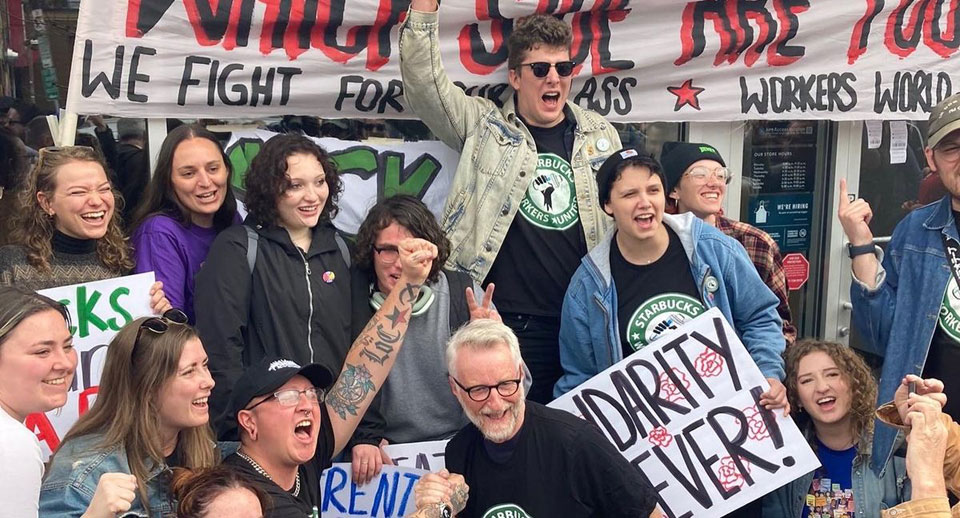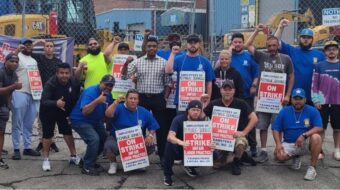
WASHINGTON—The U.S. had 14.285 million union members in calendar 2022, 273,000 more than the year before, the Bureau of Labor Statistics annual survey reported. But because the workforce grew faster as the nation recovered from the coronavirus-caused depression of 2021, union density declined 0.2% to 10.1%, BLS added.
All the gains came in the private sector, where union membership increased by 293,000, to 7.223 million. But the public sector, which has yet to fully recover from job losses the virus-caused crash produced, reported 7.062 million members, plus 823,000 “free riders” who use union services but don’t pay one red cent for them.
Even the BLS’s overall number, and the increase, may be low. BLS bases its numbers on a rolling survey of 60,000 workers through the year, not the individual membership reports unions file with another section of the Labor Department, or union election wins and losses the National Labor Relations Board compiles.
And the union numbers in any year don’t include the “free riders,” workers contracts cover who aren’t members. There were 1.7 million of them in 2022, BLS’s survey said, again 200,000 more than the year before.
In a statement, AFL-CIO President Liz Shuler noted the absolute numbers of unionists grew despite intense corporate union-busting by goliaths such as Amazon and Starbucks.
“In 2022, we saw working people rising up despite often illegal opposition from companies that would rather pay union-busting firms millions than give workers a seat at the table,” she said. “The momentum of the moment we are in is clear.
“Organizing victories are happening in every industry, public and private, and every sector of our economy all across the country. The wave of organizing will continue to gather steam in 2023 and beyond despite broken labor laws that rig the system against workers.”
The federation used the data to again argue for lawmakers to pass the Protecting the Right to Organize (PRO) Act and the Public Service Freedom to Negotiate Act, “which will hold union-busting companies and organizations accountable and give workers the negotiating power they deserve.” Then, “anyone who wants to join a union on the job can do so.”
The BLS numbers also don’t reflect the tide of union elections last year. In fiscal 2022 alone, which covered the first nine months of the calendar year, the National Labor Relations Board reported running 1,522 union elections, up 59.5% from 954 the year before. Those figures lag behind, too, because they don’t include wins and losses in October-December 2022.
Just in the last two weeks of December, for example, the board certified a 13-5 win among 42 workers at a Starbucks in Columbus, Ohio, the Pennsylvania Association of Nurses and Health Professionals won 191-64 at the Geisinger Medical Center outside Scranton-Wilkes Barre, Pa., and there was a 99-3 landslide for Office and Professional Employees Local 153 at Tufts University in Massachusetts.
Also not reflected in a survey: AFSCME’s tsunami of support at Chicago’s Art Institute (410-33) among 600 workers in December or AFT Local 5221’s two wins by a combined 12-0 margin—everybody voted—at the University of Vermont Medical Center in Burlington. There were dozens of other wins.
Nor, for that matter, the most-publicized win of 2022: The independent Amazon Labor Union’s victory at the monster shipping firm’s Staten Island JFK8 warehouse. Thanks to having to plow through, and reject, a tide of employer objections, NLRB didn’t certify that 2,654-2,131 victory until late December. The warehouse employs 8,325 workers.
As usual, union density was highest in the Northeast and the Pacific Coast, with the Great Lakes states not far behind. Hawaii (21.9%), led, with New York (20.7%) second. One of every six workers in Alaska, Oregon and California were union members in the survey.
So were 13.1% of workers in Illinois, 14% in Michigan—where numbers and density rose despite the GOP-run legislature’s right-to-work laws—14.1% in Pennsylvania and 14.9% in New Jersey. Anti-union South Carolina (1.7%) was last and North Carolina (2.8%) was just above it.
The numbers also reinforce another message: The union edge in wages, roughly a 20% premium—a median weekly wage of $1,219–over wages non-union workers earn ($1,029).
The federation predicted the numbers, and density, would turn upwards in the future, as all the organizing now pays off in wins and contracts.
“The data don’t capture the surge in worker organizing across every sector, from teaching assistants to baristas to museum workers, construction workers, video game developers and many more. With the resurgence of union organizing and unprecedented federal investment in job creation, the labor movement is poised to grow significantly in the coming years,” it said.










